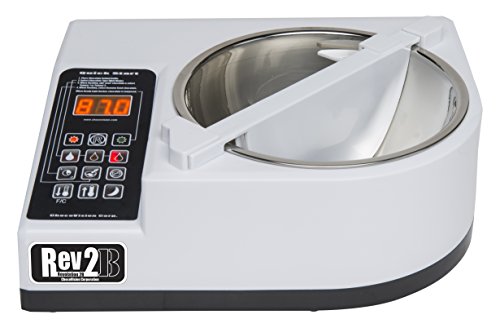Get on Amazon Tempering Machines

The final process for preparing chocolate is called tempering. Uncontrolled crystallization of cocoa butter typically results in crystals of varying size, some or all large enough to be clearly seen with the naked eye. This causes the surface of the chocolate to appear mottled and matte, and causes the chocolate to crumble rather than snap when broken. The uniform sheen and crisp bite of properly processed chocolate are the result of consistently small cocoa butter crystals produced by the tempering process.
The fats in cocoa butter can crystallize in six different forms (polymorphous crystallization). The primary purpose of tempering is to assure that only the best form is present. The six different crystal forms have different properties.
Crystal Melting temp. Notes
I 17 °C (63 °F) Soft, crumbly, melts too easily
II 21 °C (70 °F) Soft, crumbly, melts too easily
III 26 °C (79 °F) Firm, poor snap, melts too easily
IV 28 °C (82 °F) Firm, good snap, melts too easily
V 34 °C (93 °F) Glossy, firm, best snap, melts near body temperature (37 °C)
VI 36 °C (97 °F) Hard, takes weeks to form
Molten chocolate and a piece of a chocolate bar
As a solid piece of chocolate, the cocoa butter fat particles are in a crystalline rigid structure that gives the chocolate its solid appearance. Once heated, the crystals of the polymorphic cocoa butter are able to break apart from the rigid structure and allow the chocolate to obtain a more fluid consistency as the temperature increases – the melting process. When the heat is removed, the cocoa butter crystals become rigid again and come closer together, allowing the chocolate to solidify.
The temperature in which the crystals obtain enough energy to break apart from their rigid conformation would depend on the milk fat content in the chocolate and the shape of the fat molecules, as well as the form of the cocoa butter fat. Chocolate with a higher fat content will melt at a lower temperature.
Making chocolate considered “good” is about forming as many type V crystals as possible. This provides the best appearance and texture and creates the most stable crystals, so the texture and appearance will not degrade over time. To accomplish this, the temperature is carefully manipulated during the crystallization.
Various chocolate types
Generally, the chocolate is first heated to 45 °C (113 °F) to melt all six forms of crystals. Next, the chocolate is cooled to about 27 °C (81 °F), which will allow crystal types IV and V to form. At this temperature, the chocolate is agitated to create many small crystal “seeds” which will serve as nuclei to create small crystals in the chocolate. The chocolate is then heated to about 31 °C (88 °F) to eliminate any type IV crystals, leaving just type V. After this point, any excessive heating of the chocolate will destroy the temper and this process will have to be repeated. Other methods of chocolate tempering are used as well. The most common variant is introducing already tempered, solid “seed” chocolate. The temper of chocolate can be measured with a chocolate temper meter to ensure accuracy and consistency. A sample cup is filled with the chocolate and placed in the unit which then displays or prints the results.
Two classic ways of manually tempering chocolate are:
Working the molten chocolate on a heat-absorbing surface, such as a stone slab, until thickening indicates the presence of sufficient crystal “seeds”; the chocolate is then gently warmed to working temperature.
Stirring solid chocolate into molten chocolate to “inoculate” the liquid chocolate with crystals (this method uses the already formed crystals of the solid chocolate to “seed” the molten chocolate).
Chocolate tempering machines (or temperers) with computer controls can be used for producing consistently tempered chocolate. In particular, continuous tempering machines are used in large volume applications. Various methods and apparatuses for continuous flow tempering have been described by Aasted, Sollich and Buhler, three manufacturers of commercial chocolate equipment, with a focus now on energy efficiency. In general, molten chocolate coming in at 40–50 °C is cooled in heat exchangers to crystallization temperates of about 26–30 °C, passed through a tempering column consisting of spinning plates to induce shear, then warmed slightly to re-melt undesirable crystal formations.
As an Amazon Associate I earn from qualifying purchases.
Categories: Product Reviews
Sorry, comments are closed for this item.
